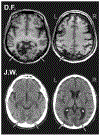Real-world size coding of solid objects, but not 2-D or 3-D images, in visual agnosia patients with bilateral ventral lesions
- PMID: 30987739
- PMCID: PMC6733679
- DOI: 10.1016/j.cortex.2019.02.030
Real-world size coding of solid objects, but not 2-D or 3-D images, in visual agnosia patients with bilateral ventral lesions
Abstract
Patients with visual agnosia show severe deficits in recognizing two-dimensional (2-D) images of objects, despite the fact that early visual processes such as figure-ground segmentation, and stereopsis, are largely intact. Strikingly, however, these patients can nevertheless show a preservation in their ability to recognize real-world objects -a phenomenon known as the 'real-object advantage' (ROA) in agnosia. To uncover the mechanisms that support the ROA, patients were asked to identify objects whose size was congruent or incongruent with typical real-world size, presented in different display formats (real objects, 2-D and 3-D images). While recognition of images was extremely poor, real object recognition was surprisingly preserved, but only when physical size matched real-world size. Analogous display format and size manipulations did not influence the recognition of common geometric shapes that lacked real-world size associations. These neuropsychological data provide evidence for a surprising preservation of size-coding of real-world-sized tangible objects in patients for whom ventral contributions to image processing are severely disrupted. We propose that object size information is largely mediated by dorsal visual cortex and that this information, together with detailed representation of object shape which is also subserved by dorsal cortex, serve as the basis of the ROA.
Keywords: Object recognition; Real-world objects; Real-world size; Two-dimensional images; Visual form agnosia.
Copyright © 2019 Elsevier Ltd. All rights reserved.
Conflict of interest statement
DECLARATIONS
Declarations of interest: none
Figures





References
Publication types
MeSH terms
Grants and funding
LinkOut - more resources
Full Text Sources

